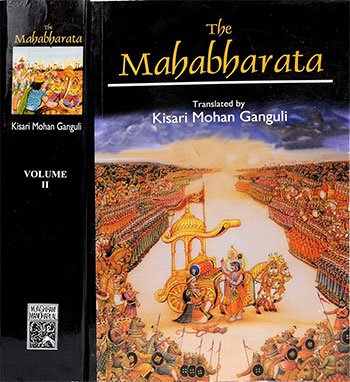Section CVII - King Sagara's Sons and the Descendants: A Tale of Sacrifice and Redemption
Book index: Mahabharata (English)
This page contains a summary of the Mahabharata Section CVII including examples of moral lessons in daily life. The Maha-Bharata is one of the largest epics ever written containing roughly 100,000 Sanskrit verses. It deals with the legendary history of ancient India and contains a large number of interwoven tales.
Short summary of the chapter:
King Sagara, upon hearing a celestial voice, followed instructions to divide a gourd into sixty thousand pieces and place them in vessels filled with clarified butter, resulting in the birth of powerful sons gifted with great strength. These sons, unruly and ruthless, terrorized gods and beings, leading everyone to seek refuge with Brahma, who prophesied their destruction. The sons’ quest for a sacrificial horse led to their demise at the hands of the sage Kapila, leaving Sagara devastated and seeking redemption through his grandson Ansuman.
Ansuman, guided by Kapila, found the horse and brought it back to Sagara, who was relieved to hear of its return and the purification of his sons through Ansuman’s efforts. Sagara honored Ansuman and completed his sacrificial rites, earning praise from the gods and transforming the ocean into a son. Successively, Ansuman’s son Dilipa ruled justly and tried in vain to bring Ganga to Earth to cleanse his ancestors' sins, eventually passing on the task to his son, the virtuous Bhagiratha.
Bhagiratha, dedicated to fulfilling his father's mission, performed rigorous penance to bring Ganga down to Earth, ultimately succeeding due to his devotion and righteousness. Ganga’s descent cleansed Sagara's sons, allowing them to attain salvation, and she flowed across the land, blessing it with purity. Dilipa, satisfied with his lineage’s redemption, renounced his throne and ascended to heaven, leaving behind a legacy of virtue and righteous deeds. Through generations of noble rulers and selfless actions, the tale of King Sagara and his descendants exemplifies the power of perseverance and faith in overcoming obstacles and achieving spiritual liberation.
Full English translation:
This page is merely a summary which is automatically generated. If you are looking for authentic sources such as the Sanskrit text or the Full English translation of Mahabharata Section CVII - King Sagara's Sons and the Descendants: A Tale of Sacrifice and Redemption, have a look at the following articles:
Section CVII, online text
English translation by Kisari Mohan Ganguli.
Read this and other chapters online.
Mahabharata (English Summary)
by Kisari Mohan Ganguli | ISBN-10: 8121505933
Buy the latest edition:
FAQ of Mahabharata, Section CVII:
What was the reason behind King Sagara abandoning his son Asamanjas?
King Sagara banished Asamanjas for throwing townsmen's children into the river, causing fear and grief.
How did Sagara's sons meet their end in the ocean?
Sagara's sons angered Kapila, who burnt them to ashes with flames.
What did Ansuman do to retrieve the sacrificial horse for King Sagara?
Ansuman entered the sea, met Kapila, and obtained the horse.
How did King Dilipa try to bring Ganga to the mortal world, and what was the outcome?
Despite his efforts, Dilipa couldn't bring Ganga down to earth.
Daily life: King Sagara's Sons and the Descendants: A Tale of Sacrifice and Redemption:
The story encompasses profound themes of duty, sacrifice, and redemption, resonating deeply with the virtues essential for personal development and societal well-being. At its core, the tale illustrates the significance of faith, persistence, and the relentless pursuit of righteous goals. Through the character of King Sagara, who confronts adversity with unwavering determination to fulfill his responsibilities, we learn the importance of commitment to one's duties, regardless of the challenges that may arise. The narrative showcases how belief in a higher purpose and adherence to moral principles can guide individuals through difficult times, leading to the eventual triumph of good over adversity.
Moreover, the actions of Ansuman and Bhagiratha highlight the virtues of respect for elders and ancestors, showcasing the impact of perseverance and devotion in achieving seemingly impossible tasks. Their journey underscores the idea that honoring one's heritage and striving for the collective good can bring about transformative changes, not only for oneself but for the wider community. By embodying these values, individuals can pave the way for positive change, inspiring others to contribute towards a more harmonious and compassionate society.
In essence, the story teaches us that through dedication, ethical conduct, and respect for our roots, we can overcome obstacles and effect meaningful change. It encourages us to remain steadfast in our endeavors, guided by the principles of righteousness and service, to fulfill our duties and leave a lasting legacy. By integrating these lessons into our daily lives, we can navigate the complexities of modern existence with grace and integrity, fostering a better world for future generations.
